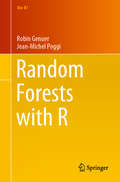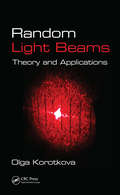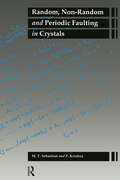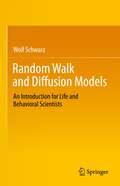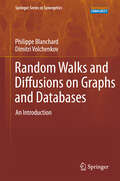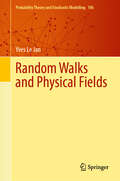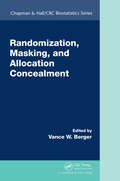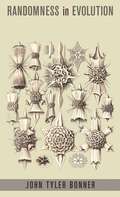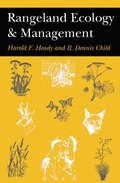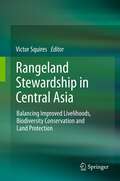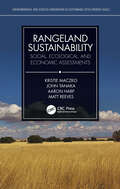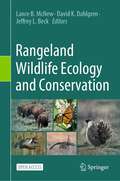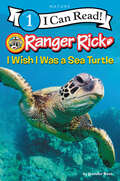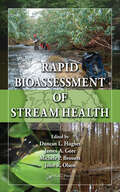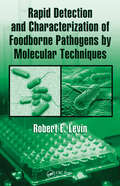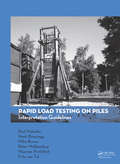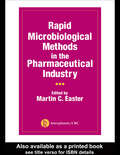- Table View
- List View
Random Forests with R (Use R!)
by Jean-Michel Poggi Robin GenuerThis book offers an application-oriented guide to random forests: a statistical learning method extensively used in many fields of application, thanks to its excellent predictive performance, but also to its flexibility, which places few restrictions on the nature of the data used. Indeed, random forests can be adapted to both supervised classification problems and regression problems. In addition, they allow us to consider qualitative and quantitative explanatory variables together, without pre-processing. Moreover, they can be used to process standard data for which the number of observations is higher than the number of variables, while also performing very well in the high dimensional case, where the number of variables is quite large in comparison to the number of observations. Consequently, they are now among the preferred methods in the toolbox of statisticians and data scientists. The book is primarily intended for students in academic fields such as statistical education, but also for practitioners in statistics and machine learning. A scientific undergraduate degree is quite sufficient to take full advantage of the concepts, methods, and tools discussed. In terms of computer science skills, little background knowledge is required, though an introduction to the R language is recommended. Random forests are part of the family of tree-based methods; accordingly, after an introductory chapter, Chapter 2 presents CART trees. The next three chapters are devoted to random forests. They focus on their presentation (Chapter 3), on the variable importance tool (Chapter 4), and on the variable selection problem (Chapter 5), respectively. After discussing the concepts and methods, we illustrate their implementation on a running example. Then, various complements are provided before examining additional examples. Throughout the book, each result is given together with the code (in R) that can be used to reproduce it. Thus, the book offers readers essential information and concepts, together with examples and the software tools needed to analyse data using random forests.
Random Light Beams: Theory and Applications
by Olga KorotkovaRandom Light Beams: Theory and Applications contemplates the potential in harnessing random light. This book discusses light matter interactions, and concentrates on the various phenomena associated with beam-like fields. It explores natural and man-made light fields and gives an overview of recently introduced families of random light beams. It outlines mathematical tools for analysis, suggests schemes for realization, and discusses possible applications. The book introduces the essential concepts needed for a deeper understanding of the subject, discusses various classes of deterministic paraxial beams and examines random scalar beams. It highlights electromagnetic random beams and matters relating to generation, propagation in free space and various media, and discusses transmission through optical systems. It includes applications that benefit from the use of random beams, as well as the interaction of beams with deterministic optical systems.• Includes detailed mathematical description of different model sources and beams• Explores a wide range of man-made and natural media for beam interaction • Contains more than 100 illustrations on beam behavior• Offers information that is based on the scientific results of the last several years • Points to general methods for dealing with random beams, on the basis of which the readers can do independent researchIt gives examples of light propagation through the human eye, laser resonators, and negative phase materials. It discusses in detail propagation of random beams in random media, the scattering of random beams from collections of scatterers and thin random layers as well as the possible uses for these beams in imaging, tomography, and smart illumination.
Random Matrix Theory with an External Source
by Edouard Brézin Shinobu HikamiThis is a first book to show that the theory of the Gaussian random matrix is essential to understand the universal correlations with random fluctuations and to demonstrate that it is useful to evaluate topological universal quantities. We consider Gaussian random matrix models in the presence of a deterministic matrix source. In such models the correlation functions are known exactly for an arbitrary source and for any size of the matrices. The freedom given by the external source allows for various tunings to different classes of universality. The main interest is to use this freedom to compute various topological invariants for surfaces such as the intersection numbers for curves drawn on a surface of given genus with marked points, Euler characteristics, and the Gromov-Witten invariants. A remarkable duality for the average of characteristic polynomials is essential for obtaining such topological invariants. The analysis is extended to nonorientable surfaces and to surfaces with boundaries.
Random Non-Random Periodic Fau
by M. T. Sebastian P. KrishnaThis book provides a comprehensive overview of stacking faults in crystal structures. Subjects covered include: notations used in representations of close-packed structures; types of faults; methods of detection and measurement such as X-ray diffraction, electron diffraction and other techniques; theoretical models of non-random faulting during phase transitions; specific examples of - close packed structures including, zinc sulphide, silicon carbide and silver iodide.
Random Walk and Diffusion Models: An Introduction for Life and Behavioral Scientists
by Wolf SchwarzThis book offers an accessible introduction to random walk and diffusion models at a level consistent with the typical background of students in the life sciences. In recent decades these models have become widely used in areas far beyond their traditional origins in physics, for example, in studies of animal behavior, ecology, sociology, sports science, population genetics, public health applications, and human decision making. Developing the main formal concepts, the book provides detailed and intuitive step-by-step explanations, and moves smoothly from simple to more complex models. Finally, in the last chapter, some successful and original applications of random walk and diffusion models in the life and behavioral sciences are illustrated in detail. The treatment of basic techniques and models is consolidated and extended throughout by a set of carefully chosen exercises.
Random Walks and Diffusions on Graphs and Databases
by Dimitri Volchenkov Philipp BlanchardMost networks and databases that humans have to deal with contain large, albeit finite number of units. Their structure, for maintaining functional consistency of the components, is essentially not random and calls for a precise quantitative description of relations between nodes (or data units) and all network components. This book is an introduction, for both graduate students and newcomers to the field, to the theory of graphs and random walks on such graphs. The methods based on random walks and diffusions for exploring the structure of finite connected graphs and databases are reviewed (Markov chain analysis). This provides the necessary basis for consistently discussing a number of applications such diverse as electric resistance networks, estimation of land prices, urban planning, linguistic databases, music, and gene expression regulatory networks.
Random Walks and Physical Fields (Probability Theory and Stochastic Modelling #106)
by Yves Le JanThis book presents fundamental relations between random walks on graphs and field theories of mathematical physics. Such relations have been explored for several decades and remain a rapidly developing research area in probability theory.The main objects of study include Markov loops, spanning forests, random holonomies, and covers, and the purpose of the book is to investigate their relations to Bose fields, Fermi fields, and gauge fields. The book starts with a review of some basic notions of Markovian potential theory in the simple context of a finite or countable graph, followed by several chapters dedicated to the study of loop ensembles and related statistical physical models. Then, spanning trees and Fermi fields are introduced and related to loop ensembles. Next, the focus turns to topological properties of loops and graphs, with the introduction of connections on a graph, loop holonomies, and Yang–Mills measure. Among the main results presented is an intertwining relation between merge-and-split generators on loop ensembles and Casimir operators on connections, and the key reflection positivity property for the fields under consideration.Aimed at researchers and graduate students in probability and mathematical physics, this concise monograph is essentially self-contained. Familiarity with basic notions of probability, Poisson point processes, and discrete Markov chains are assumed of the reader.
Randomization, Masking, and Allocation Concealment (Chapman & Hall/CRC Biostatistics Series)
by Vance BergerRandomization, Masking, and Allocation Concealment is indispensable for any trial researcher who wants to use state of the art randomization methods, and also wants to be able to describe these methods correctly. <P><P>Far too often the subtle nuances that distinguish proper randomization from flawed randomization are completely ignored in trial reports that state only that randomization was used, with no additional information. Experience has shown that in many cases, the type of randomization that was used was flawed. It is only a matter of time before medical journals and regulatory agencies come to realize that we can no longer rely on (or publish) flawed trials, and that flawed randomization in and of itself disqualifies a trial from being robust or high quality, even if that trial is of high quality otherwise. <P><P>This book will help to clarify the role randomization plays in ensuring internal validity, and in drawing valid inferences from the data. The various chapters cover a variety of randomization methods, and are not limited to the most common (and most flawed) ones. Readers will come away with a profound understanding of what constitutes a valid randomization procedure, so that they can distinguish the valid from the flawed among not only existing methods but also methods yet to be developed.
Randomness in Evolution
by John Tyler BonnerThe important role that randomness plays in evolutionary changeJohn Tyler Bonner, one of our most distinguished and insightful biologists, here challenges a central tenet of evolutionary biology. In this concise, elegantly written book, he makes the bold and provocative claim that some biological diversity may be explained by something other than natural selection.With his customary wit and accessible style, Bonner makes an argument for the underappreciated role that randomness—or chance—plays in evolution. Due to the tremendous and enduring influence of Darwin's natural selection, the importance of randomness has been to some extent overshadowed. Bonner shows how the effects of randomness differ for organisms of different sizes, and how the smaller an organism is, the more likely it is that morphological differences will be random and selection may not be involved to any degree. He traces the increase in size and complexity of organisms over geological time, and looks at the varying significance of randomness at different size levels, from microorganisms to large mammals. Bonner also discusses how sexual cycles vary depending on size and complexity, and how the trend away from randomness in higher forms has even been reversed in some social organisms.Certain to provoke lively discussion, Randomness in Evolution is a book that may fundamentally change our understanding of evolution and the history of life.
Rangeland Ecology And Management
by Harold Heady R. Dennis ChildOver the last two decades the science of range management, like many other resource disciplines, has embraced and integrated environmental concerns in the field, the laboratory, and policy. Rangeland Ecology and Management now brings this integrated approach to the classroom in a thoroughly researched, comprehensive, and readable text. The authors discuss the basics of rangeland management--including grazing and practical management of animals and vegetation--and place those basics within the context of decision making for damaged land, riparian and water conservation, multiple use, and modeling. Concepts such as succession, stability, and range condition are examined and their effects discussed. Fire is considered as an environmental factor. Appendixes provide scientific and common names of range plants and animals. These and many other issues crucial to the understanding of successful range management combine to make the finest text for upper-level undergraduates now available.
Rangeland Stewardship in Central Asia
by Victor R. SquiresThis volume of 18 chapters is the work of more than 30 authors, many of whom are natives of the Central Asian region or are researchers who have dedicated a large part of their working lives to studying the development dynamics in this vast and fascinating region. The work focuses on the 20 years since the collapse of the Soviet Union in 1990. But it also traces the attitudes of land users to the land dating from before the late 19th century, when Russian conquest and colonization occurred, and through the upheavals caused by Soviet-style collectivization and sedentarization. The book is rich with new data presented in 68 easy to understand charts/graphs (many in color) and 50 Tables. Information was generated for this book by experts working in-country. It presents for the first time in English a digest of plethora of previously inaccessible Russian reports and scientific literature that will be invaluable for development agencies, including UN, World Bank, Asian Development Bank, Islamic Bank as well as to students of this vast and fascinating region who seek up to date and authoritive information.
Rangeland Sustainability: Social, Ecological, and Economic Assessments (Environmental and Societal Dimensions of Sustainable Development Goals)
by Kristie Maczko Aaron Harp John Tanaka Matt ReevesThis book provides an integrated description of the indicators of rangeland sustainability that capture ecological, economic, and social dimensions. It takes a fresh look at the information available on current and emerging issues across rangelands, and presents collaborative research for future progress. Authors offer a framework for evaluating rangeland sustainability, the best available data to use, as well as an interactive tool for use at a variety of geographical scales. Readers with limited knowledge of rangelands, as well as professional rangeland ecologists and land managers, will gain an understanding of the best tools available today to assess sustainability across rangeland ecosystems in the U.S.
Rangeland Wildlife Ecology and Conservation
by Lance B. McNew David K. Dahlgren Jeffrey L. BeckThis open access book reviews the importance of ecological functioning within rangelands considering the complex inter-relationships of production agriculture, ecosystem services, biodiversity, and wildlife habitat. More than half of all lands worldwide, and up to 70% of the western USA, are classified as rangelands—uncultivated lands that often support grazing by domestic livestock. The rangelands of North America provide a vast array of goods and services, including significant economic benefit to local communities, while providing critical habitat for hundreds of species of fish and wildlife. This book provides compendium of recent data and synthesis from more than 100 experts in wildlife and rangeland ecology in Western North America. It provides a current and in-depth synthesis of knowledge related to wildlife ecology in rangeland ecosystems, and the tools used to manage them, to serve current and future wildlife biologists and rangeland managers in the working landscapes of the West. The book also identifies information gaps and serves as a jumping-off point for future research of wildlife in rangeland ecosystems. While the content focuses on wildlife ecology and management in rangelands of Western North America, the material has important implications for rangeland ecosystems worldwide.
Ranger Medic Handbook
by U.S. Department of DefenseHistorically in warfare, the majority of all combat deaths have occurred prior to a casualty ever receiving advanced trauma management. The execution of the Ranger mission profile in the Global War on Terrorism and our legacy tasks undoubtedly will increase the number of lethal wounds. Ranger leaders can significantly reduce the number of Rangers who die of wounds sustained in combat by simply targeting optimal medical capability in close proximity to the point of wounding. Directing casualty response management and evacuation is a Ranger leader task; ensuring technical medical competence is a Ranger Medic task. A solid foundation has been built for Ranger leaders and medics to be successful in managing casualties in a combat environment. The true success of the Ranger Medical Team will be defined by its ability to complete the mission and greatly reduce preventable combat death. Rangers value honor and reputation more than their lives, and as such will attempt to lay down their own lives in defense of their comrades. The Ranger Medic will do no less.
Ranger Rick: I Wish I Was a Bison (I Can Read Level 1)
by Jennifer BovéExplore the lives of bison with Ranger Rick in this beginning reader with full-color photos of bison in the wild! What if you wished you were a bison and then you became one? Could you talk like a bison, with grunts and snorts? Could you eat like a bison, chomping lots and lots of grass? And would you want to? Find out!Ranger Rick explorers can learn all about bison in this reader full of fascinating facts, vivid wildlife photographs, a Wild Words glossary, and a hands-on activity that teaches kids how to to play bison Frisbee!Ranger Rick, the iconic raccoon ambassador from Ranger Rick magazines, engages young readers by comparing and contrasting the life of the bison to the life of the reader. For example, a call-out from Ranger Rick asks: would you rather take a bath or wallow in the dirt?Ranger Rick: I Wish I Was a Bison is a Level One I Can Read book, which means it’s perfect for children learning to sound out words and sentences. Whether shared at home or in a classroom, the short sentences, familiar words, and simple concepts of Level One books support success for children eager to start reading on their own.
Ranger Rick: I Wish I Was a Flamingo (I Can Read Level 1)
by Jennifer BovéExplore the lives of flamingos with Ranger Rick in this Level One I Can Read with full-color photos!What if you wished you were a flamingo and then you became one? Could you eat like a flamingo? Talk like a flamingo? Grow up in a flamingo family? And would you want to? Find out!Ranger Rick explorers can learn all about Flamingos in this reader full of fascinating facts, vivid wildlife photographs, a Wild Words glossary, and a hands-on activity.Ranger Rick: I Wish I Was a Flamingo is a level One I Can Read, which means it’s perfect for children learning to sound out words and sentences.This I Can Read story is perfect for children ages 5 to 7 who are ready to read independently. It’s an excellent choice to keep your kids engaged during homeschooling. This beginning reader is an ideal boredom buster when home from school; it's a great activity for kids, and it helps prevent summer slide.
Ranger Rick: I Wish I Was a Llama (I Can Read Level 1)
by Jennifer BovéExplore the lives of llamas with Ranger Rick in this beginning reader with full-color photos of llamas in action! What if you wished you were a llama and then you became one? Could you talk like a llama, with gurgles and squeals? Could you roll in the dust like a llama, to keep bugs away? And would you want to? Find out about llamas and their wild cousins, guanacos (pronounced wah-nah-ko), as well as alpacas and vicuñas!Ranger Rick explorers will love this Level One I Can Read that helps beginning readers dig a little deeper into the lives of llamas. Ranger Rick: I Wish I Was a Llama is complete with vivid photographs, fascinating facts, a Wild Words glossary, and a hands-on activity about how to tell the difference between different camelids.Ranger Rick, the iconic raccoon ambassador from Ranger Rick magazines, engages young readers by comparing and contrasting the life of the llama to the life of the reader. For example, a call-out from Ranger Rick asks: do you hum when you feel happy?This Level One I Can Read answers questions for beginning readers about llamas and their wild cousins, guanacos. This format engages young readers by comparing and contrasting the life of these animals to the life of the reader.Ranger Rick: I Wish I Was a Llama is a Level One I Can Read book, which means it’s perfect for children learning to sound out words and sentences. Whether shared at home or in a classroom, the short sentences, familiar words, and simple concepts of Level One books support success for children eager to start reading on their own.
Ranger Rick: I Wish I Was a Monarch Butterfly (I Can Read Level 1)
by Jennifer BovéExplore the lives of monarch butterflies with Ranger Rick in this beginning reader with full-color photos of monarchs in the wild! What if you wished you were a monarch and then you became one? Could you transform from a caterpillar into a butterfly, and learn to fly? And would you want to? Find out!Ranger Rick explorers can learn all about monarch butterflies in this reader full of fascinating facts, vivid wildlife photographs, a Wild Words glossary, and a hands-on activity that teaches kids how to chart the life cycle of the monarch.Ranger Rick, the iconic raccoon ambassador from Ranger Rick magazines, engages young readers by comparing and contrasting the life of the monarch to the life of the reader. For example—when explaining how monarch butterflies eat, a call-out from Ranger Rick asks: do you sip juice through a straw?Ranger Rick: I Wish I Was a Monarch Butterfly is a Level One I Can Read book, which means it’s perfect for children learning to sound out words and sentences. Whether shared at home or in a classroom, the short sentences, familiar words, and simple concepts of Level One books support success for children eager to start reading on their own.
Ranger Rick: I Wish I Was a Sea Turtle (I Can Read Level 1)
by Jennifer BovéWhat if you wished you were a sea turtle and then you became one? Could you eat like a sea turtle? Sleep like a sea turtle? Spend most of your life underwater? And would you want to? Find out! Ranger Rick explorers can learn all about sea turtles in this reader full of fascinating facts, vivid wildlife photographs, a Wild Words glossary, and a hands-on activity. Ranger Rick: I Wish I Was a Sea Turtle is a Guided Reading Level K and a level One I Can Read, which means it’s perfect for children learning to sound out words and sentences. Whether shared at home or in a classroom, the short sentences, familiar words, and simple concepts of Level One books support success for children eager to start reading on their own.
Rani Choudhury Must Die
by Adiba JaigirdarIn this sapphic dual POV romance by Adiba Jaigirdar, Meghna and Rani (ex-best-friends-turned-rivals) realize they're dating the same guy, so they team up to beat and expose him at a big science competition! Meghna Rahman is tired of constantly being compared to her infuriatingly perfect ex best friend now rival. Everyone, except, at least, her boyfriend Zak, seems to think that Rani Choudhury can do no wrong—even her own parents! It doesn’t help that Rani is always accepted into the Young Scientist Exhibition, while Meghna’s projects never make it. But this year, she finally has a chance at defeating Rani in something.Rani Choudhury is tired of feeling like she doesn’t have much say in her life—not when it comes to how her mom wants her to look and act or how her parents encourage her to date incredibly charming close family friend Zak. She would much rather focus on her coding, especially once she places high enough at the Young Scientist Exhibition to go on to the European Young Scientist ExhibitionWhen Meghna and Rani figure out that Zak has been playing them both, they decide to do something no one would see coming: they team up. They’ll compete in the EYSE as partners, creating an app that exposes cheaters and a project that exposes Zak. But with years of silence and pressure between them, working together will prove difficult. Especially once each girl starts to realize that the feelings they had for the other may have been more than platonic...Hey, no one ever said science was easy!
Rank and Pseudo-Rank Procedures for Independent Observations in Factorial Designs: Using R and SAS (Springer Series in Statistics)
by Edgar Brunner Arne C. Bathke Frank KonietschkeThis book explains how to analyze independent data from factorial designs without having to make restrictive assumptions, such as normality of the data, or equal variances. The general approach also allows for ordinal and even dichotomous data. The underlying effect size is the nonparametric relative effect, which has a simple and intuitive probability interpretation. The data analysis is presented as comprehensively as possible, including appropriate descriptive statistics which follow a nonparametric paradigm, as well as corresponding inferential methods using hypothesis tests and confidence intervals based on pseudo-ranks. Offering clear explanations, an overview of the modern rank- and pseudo-rank-based inference methodology and numerous illustrations with real data examples, as well as the necessary R/SAS code to run the statistical analyses, this book is a valuable resource for statisticians and practitioners alike.
Rapid Bioassessment of Stream Health
by John R. Olson Duncan L. Hughes James Gore Michele P. BrossettTasked by the Clean Water Act to restore and maintain the integrity of their waters, state and local governments must develop systems for assessing the health of the streams within their borders. They quickly find that one size does not fit all when it comes to sampling. Rapid Bioassessment of Stream Health examines the sampling techniques, laborat
Rapid Detection and Characterization of Foodborne Pathogens by Molecular Techniques
by Robert E. LevinWritten by one of the most prolific and respected researchers in food safety, this volume describes molecular techniques for the detection and discrimination of major infectious bacteria associated with foods. Each chapter deals with a specific organism and techniques applied to that organism. Particular focus is placed on genes associated with pathogenicity used in the polymerase chain reaction (PCR) including real-time PCR for specific detection of pathogenic bacteria and the inherent limitations of such methodology with certain pathogens. Methods for extracting microorganisms from complex food matrices andDNA purification techniques are also emphasized.
Rapid Load Testing on Piles: Interpretation Guidelines
by Paul Holscher Henk Brassinga Michael Brown Peter Middendorp Maarten Profittlich Frits A. van TolA Rapid Load Test (RLT), developed to determine the initial stiffness and bearing capacity, is an economical and practical alternative to a Static Load Test (SLT). The broad application of RLT, however, was hampered by uncertainty about the interpretation of the test results. This book offers clear guidance on the available analysis techniques and
Rapid Microbiological Methods in the Pharmaceutical Industry
by Martin C. EasterIn recent years there has been increased interest in the possibility of rapid microbiological methods offering enhanced potential error detection capabilities. However, these methods raise a number of questions, such as how to validate new methods, will they be accepted by the pharmacopoeias, and, most importantly, how will the regulators respond?
